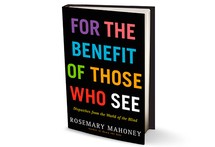For the Benefit of Those Who See
By Rosemary Mahoney
304 pages;
Little, Brown
A journalist ventures into the heart of blindness.
Perceived throughout history as ominous soothsayers, helpless idiots, or louche vagrants and beggars, blind people, as Rosemary Mahoney dryly notes in her sparkling exploration, For the Benefit of Those Who See: Dispatches from the World of the Blind, "have not come off very well." Mahoney, a gifted writer whose previous work includes the highly praised Down the Nile: Alone in a Fisherman's Skiff, sets out to turn the tables on these stereotypes, and the lack of understanding that prompts them in the first place, using herself as case in point.
She finds, for example, that the blind students she encounters often form more detailed and accurate impressions of her than she does of them. The sighted base their assessments of people largely on appearance, according to Sabriye Tenberken, the remarkable woman who first brought literacy to the blind in Tibet and is one of the subjects of the book. The sighted can be distracted by beauty, or its absence, Tenberken says, whereas the blind "have to focus on the personality, which is the real essence of the person. It can be an advantage for us."
Before meeting Tenberken, Mahoney had spent time with only one blind person and was convinced that she'd prefer death to losing her sight. However, by the end of her journey, which takes her from Tibet to Liberia and through the history of blindness, she begins to experience the world in all its "beautiful darkness": the lowing of cows, the rattling of the wind in palm fronds, cool lake water against her skin.
"Sight is a slick and overbearing autocrat," Mahoney concludes, "trumpeting its prodigal knowledge and perceptions so forcefully that it drowns out the other, subtler senses." When you finish the book, walk outside and close your eyes. You just might meet the world again, startling, mysterious, new.
— Lynn Darling


